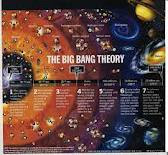In cosmology, the Big Bang is the scientific theory that describes the early development and shape of the universe.It is the most accepted theory for the origin and
evolution of our universe. It states that at some time
in the distant past there was nothing, around 10 to 14
billion years ago, the part of the universe we can see today was only a
few millimeters across. According to this theory, at the beginning of
time, all of the matter and energy in the universe was concentrated in a
very dense state, from which it "exploded" and this is known as the Big
Bang.
From a
dense, hot ball of gas, radiation and subatomic particles emerged. This exploded
and began expanding rapidly outward. As it expanded it cooled and
electrons, protons and neutrons formed. As the universe grew in size,
the temperature dropped, which eventually formed huge numbers of
Hydrogen, Helium and Lithium nuclei. After many millions of years the
expanding universe, at first a very hot gas, thinned and cooled enough
to condense into individual galaxies and then stars. Stars and galaxies
began to form about one billion years following the Big Bang. It has
since expanded from this hot dense state into the vast and much cooler
cosmos we currently inhabit.
Provided the supporting evidence showed by an American astronomer Edwin Hubble for the Big Bang Theory, his 1929 discovery as the first evidence that the
light of distant galaxies was generally shifted toward the red end of
the spectrum, this is called the Red Shift.This happens when stars are
moving rapidly away from Earth. This evidence means that it is obvious
that the universe is expanding.The second evidence is that this theory predicts that 25 percent of
the total mass of the universe should be the helium that formed during
the first few minutes, an amount that agrees with observations.Thirdly, a cosmic background noise was the discovery in 1965, is
received from every part of the sky. This background radiation has the
same intensity and distribution of frequencies in all directions and is
not linked with any individual celestial object. It has a black body
temperature of -270 deg C and is interpreted as the electromagnetic
remnant of the primordial fireball, stretched to long wavelengths by the
expansion of the universe.
Other evidence that supports the big bang theory is the Isotropy of
observable universe. Proponents of big bang also mention isotropy of the
observable universe to one part in one hundred thousand as evidence
that big bang is valid. They further state that what minute anisotropy
does exist is consistent with big bang hypotheses which include the dark
matter hypotheses.Also Quasars are predicted to only be possible in the early stages of
an active cosmos by the Big Bang theory, and observation evidence
supports this, as quasar populations become denser the further away when
you look at them.
But the most convincing evidence is the presence of the cosmic
background radiation, a theoretical prediction about photons left over
from the big bang. The big-bang theory predicted this remnant radiation,
which now glows at a temperature just 3 degrees above absolute zero.
Cosmic Background Explorer (COBE) satellite, launched in 1989, showed
that 99.97% of the radiant energy of the universe was released within
the first year of the Big Bang event.
God's 7 days creation:
The bible presents the creation of the universe by god in a literal
seven day creation, however only taking six days to finish his work, and
resting on the seventh day. God first created the all elements, then
the environment, after that the animal kingdom and lastly but not least
humans. This is how the bible informs us on God's universe creation.
- The First Day, God said "Let there be light" and light was created.
- The Second Day God created the waters, However there was no liquid water, no oceans. All of the water was in the form of a vapour, a "super fog". God then made most of the water to condense onto the cooling earth which straight away formed a whole planet of ocean and cleared the sky.
- The Third Day God made the dry grounds. This is also where plate tectonics took place. The earth changed from a smooth one-level molten "cue ball" to a planet with an uneven surface with ocean basins and continental landmasses (countries). Dry ground resulted to the first plants grown.
- The Fourth Day the sky was clear and you could see the sun, moon and stars. They were put here for a reason, to act as indicate our seasons, days, and years. Sunset and sunset equals one day. A moon cycle equals a month. And stars presented the seasons.
- The Fifth Day a variety of birds and sea creatures were created and blessed.
- The Sixth Day a huge amount of land animals was created, including man (later on women, known as Adam and Eve)
- The Seventh Day also known as the Sabbath Day was when God finally finished his work, and took a rest. He stopped creating anything else and rest of his work. He blessed this day and made it holly. This is why we go to church on Sunday, the seventh day, the Sabbath day.







No comments:
Post a Comment